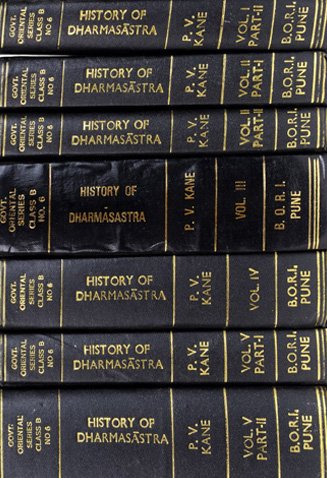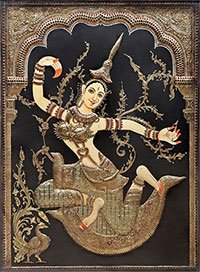Mrigaya, Mṛgaya, Mṛgayā: 20 definitions
Introduction:
Mrigaya means something in Hinduism, Sanskrit, the history of ancient India, Marathi, Hindi. If you want to know the exact meaning, history, etymology or English translation of this term then check out the descriptions on this page. Add your comment or reference to a book if you want to contribute to this summary article.
The Sanskrit terms Mṛgaya and Mṛgayā can be transliterated into English as Mrgaya or Mrigaya, using the IAST transliteration scheme (?).
Alternative spellings of this word include Mragya.
In Hinduism
Purana and Itihasa (epic history)
Source: archive.org: Shiva Purana - English TranslationMṛgayā (मृगया) refers to “hunting”, which is considered as having evil influences (vyasana), according to the Śivapurāṇa 2.1.17. Accordingly, “[...] who is he that is not broken up by the evil influences (vyasana) of hunting (mṛgayā), wine (madya), slander (paiśunya), untruth (anṛta), theft (caura), gambling (durodara) and prostitutes (vāradāra)? The wicked fellow (Guṇanidhi) used to lay his hands on whatever he could see in the house, a cloth, a base metal etc. and take it to the gambling den, there to lose the same to his brother gamblers (dyūtakāra)”.
Source: Cologne Digital Sanskrit Dictionaries: The Purana Index1) Mṛgaya (मृगय).—Kaśyapa gotrakāras.*
- * Matsya-purāṇa 199. 3.
2) Mṛgayā (मृगया).—Hunting;1 to be avoided by kings.2
- 1) Brahmāṇḍa-purāṇa I. 2. 20; Vāyu-purāṇa 2. 20; 85. 27; 88. 13; 96. 37; 99. 204.
- 2) Matsya-purāṇa 220. 80

The Purana (पुराण, purāṇas) refers to Sanskrit literature preserving ancient India’s vast cultural history, including historical legends, religious ceremonies, various arts and sciences. The eighteen mahapuranas total over 400,000 shlokas (metrical couplets) and date to at least several centuries BCE.
Dharmashastra (religious law)
Source: Google Books: Manusmṛti with the ManubhāṣyaMṛgayā (मृगया) refers to the “pleasure of hunting”, which is considered as very harmful (kaṣṭatama), according to the Manusmṛti 7.50. Accordingly, “[...] hunting (mṛgayā), dice (akṣa), sleeping during the day (divāsvapna), censoriousness (parivāda), women (strī), intoxication (mada), musical triad (tauryatrika) and listless wandering (vṛthāṭyā) constitute the ten-fold set arising from the love of pleasure (kāmaja). [...] in the set arising from love of pleasure (kāmaja),—drinking (pāna), dice (akṣa), women (strī) and hunting (mṛgayā) are to be regarded as the four most pernicious (kaṣṭatama), in the order in which they are named”.
Mṛgayā (‘hunting’) refers to the “killing of animals for purposes of the chase”.

Dharmashastra (धर्मशास्त्र, dharmaśāstra) contains the instructions (shastra) regarding religious conduct of livelihood (dharma), ceremonies, jurisprudence (study of law) and more. It is categorized as smriti, an important and authoritative selection of books dealing with the Hindu lifestyle.
Ayurveda (science of life)
Source: Cracow Indological Studies: Virūpākṣa-vasantotsava-campū of AhobalaMṛgayā (मृगया) refers to the “hunting” tradition of ancient India.—The divisions of hunting and benefits of hunting were explained in a treatise titled the Śyainika-śāstra by Rājā Rudradeva of Kumaon (16 th century CE?). In Kauṭilya’s Arthaśāstra hunting is mentioned among addictions or vices (vyasana) of the human race. It is stated that if we were to choose between hunting (mṛgayā) and gambling, hunting is the worse vice since falling into the hands of robbers and enemies, getting into wild fire, fear, inability to distinguish between the cardinal points, hunger, thirst and loss of life are evils consequent upon hunting. But there are also positive things which should be said about hunting (mṛgayā), remarks Kauṭilya: it is an exercise which brings the disappearance of phlegm, bile, fat and sweat and results in the acquisition of skills such as aiming at stationary and moving bodies and the ability to predict from the appearance of a provoked beast how it would behave, etc.

Āyurveda (आयुर्वेद, ayurveda) is a branch of Indian science dealing with medicine, herbalism, taxology, anatomy, surgery, alchemy and related topics. Traditional practice of Āyurveda in ancient India dates back to at least the first millenium BC. Literature is commonly written in Sanskrit using various poetic metres.
Sports, Arts and Entertainment (wordly enjoyments)
Source: archive.org: Syainika Sastra of Rudradeva with English Translation (art)Mṛgayā (मृगया) refers to “hunting”, and represents one of the eighteen Addictions or Vices (vyasana) which are to be practised within proper bounds for the delight of the enjoyments of the world, according to the Śyainika-śāstra: a Sanskrit treatise dealing with the divisions and benefits of Hunting and Hawking, written by Rājā Rudradeva (or Candradeva) in possibly the 13th century.—Accordingly, “Now will be given a brief but complete account of mṛgayā or hunting. Though one art, it has infinite varieties, eight of which only are going to be described here. The killing of any animal by whatever means, either for the sake of its flesh or for mere pleasure, is called mṛgayā or hunting. [...]”.
There are eight subdivisions of Hunting (mṛgayā):
- āśvīna—hunting on horseback,
- sajāla—hunting by means of snares and nets,
- kālyā—hunting by means of artifice (strategem),
- yāvaśī—hunting by means of the motion of standing corn,
- sāpekṣā—hunting by means of lying in wait,
- padaprekṣā—hunting by means of a close inspection of footprints,
- śvagaṇika—hunting by means of dogs, and
- śyenapāta—hunting by means of hawks.

This section covers the skills and profiencies of the Kalas (“performing arts”) and Shastras (“sciences”) involving ancient Indian traditions of sports, games, arts, entertainment, love-making and other means of wordly enjoyments. Traditionally these topics were dealt with in Sanskrit treatises explaing the philosophy and the justification of enjoying the pleasures of the senses.
Shaivism (Shaiva philosophy)
Source: Cracow Indological Studies: Paḷḷivēṭṭa, or the ‘Royal Hunt’, in Prescriptive Literature and in Present-day Practice in KeralaMṛgayā (मृगया) (also: Paḷḷivēṭṭa) refers to the “royal hunt” as part of the “great annual festival” (mahotsava).—Festivals (utsava) are an important feature of Indian temple culture. [...] Kerala, a state in the south-west region of India, is well known for its temple festivals. The ritual manuals produced in Kerala also describe such festivals, and it is common knowledge that the temples in Kerala, perform a ‘great annual festival’ (mahotsava) that usually goes on for ten days. During this festival, several rituals are performed and among these, on the ninth day, a ritual called Paḷḷi-vēṭṭa (in local vernacular Malayalam) or ‘royal hunt’, known in some texts of other regions as mṛgayā, is performed with pomp and ceremony.

Shaiva (शैव, śaiva) or Shaivism (śaivism) represents a tradition of Hinduism worshiping Shiva as the supreme being. Closely related to Shaktism, Shaiva literature includes a range of scriptures, including Tantras, while the root of this tradition may be traced back to the ancient Vedas.
India history and geography
Source: Heidelberg: Glory of the Tiruvanantapuram Padmanabhasvami TempleMṛgayā (मृगया) or Mṛgayāvarṇana is the seventh chapter of the Syānandūrapuravarṇana-prabandha by Svāti-Tirunāḷ (1813-1846) (one of the rulers of Travancore) which deals with the different activities of the Thiruvananthapuram Temple, including ceremonies and festivals.—The seventh chapter, Mṛgayā-varṇana, gives the sequence of the royal hunt held on the ninth day of the annual festival. Its description is very close to the way it is celebrated today. [...]

The history of India traces the identification of countries, villages, towns and other regions of India, as well as mythology, zoology, royal dynasties, rulers, tribes, local festivities and traditions and regional languages. Ancient India enjoyed religious freedom and encourages the path of Dharma, a concept common to Buddhism, Hinduism, and Jainism.
Languages of India and abroad
Marathi-English dictionary
Source: DDSA: The Molesworth Marathi and English Dictionarymṛgayā (मृगया).—f S Chase, hunting, venery.
Source: DDSA: The Aryabhusan school dictionary, Marathi-Englishmṛgayā (मृगया).—f Chase, hunting.
Marathi is an Indo-European language having over 70 million native speakers people in (predominantly) Maharashtra India. Marathi, like many other Indo-Aryan languages, evolved from early forms of Prakrit, which itself is a subset of Sanskrit, one of the most ancient languages of the world.
Sanskrit dictionary
Source: DDSA: The practical Sanskrit-English dictionaryMṛgayā (मृगया).—[mṛgaṃ yātyanayā yā ghañarthe ka] Hunting, chase; मिथ्यैव व्यसनं वदन्ति मृगयामीदृग्विनोदः कुतः (mithyaiva vyasanaṃ vadanti mṛgayāmīdṛgvinodaḥ kutaḥ) Ś.2.5; मृगयाप- वादिना माठव्येन (mṛgayāpa- vādinā māṭhavyena) Ś.2; so मृगयावेष, मृगयाविहारिन् (mṛgayāveṣa, mṛgayāvihārin) &c.
Source: Cologne Digital Sanskrit Dictionaries: Shabda-Sagara Sanskrit-English DictionaryMṛgayā (मृगया).—f.
(-yā) Chase, hunting. E. mṛg to search or seek, yat aff., deriv. irr.
Source: Cologne Digital Sanskrit Dictionaries: Benfey Sanskrit-English DictionaryMṛgayā (मृगया).—i. e. mṛg, i. 10, + a, f. Chase, hunting, [Rāmāyaṇa] 3, 49, 18.
Source: Cologne Digital Sanskrit Dictionaries: Cappeller Sanskrit-English DictionaryMṛgayā (मृगया).—[feminine] hunting, chase.
Source: Cologne Digital Sanskrit Dictionaries: Monier-Williams Sanskrit-English Dictionary1) Mṛgaya (मृगय):—[from mṛg] m. Name of a demon conquered by Indra, [Ṛg-veda]
2) Mṛgayā (मृगया):—[from mṛgaya > mṛg] a f. See below.
3) [from mṛg] b f. hunting, the chase ([accusative] with √at, gam, car etc. [dative case] with √yā, nir-√yā and vi√har, to go hunting), [Manu-smṛti; Mahābhārata] etc.
4) [v.s. ...] Chase personified (as one of the attendants of Revanta), [Varāha-mihira’s Bṛhat-saṃhitā]
Source: Cologne Digital Sanskrit Dictionaries: Yates Sanskrit-English DictionaryMṛgayā (मृगया):—(yā) 1. f. Chase, hunting.
Source: DDSA: Paia-sadda-mahannavo; a comprehensive Prakrit Hindi dictionary (S)Mṛgayā (मृगया) in the Sanskrit language is related to the Prakrit words: Maaā, Maiā, Miaā, Migayā.
[Sanskrit to German]
Sanskrit, also spelled संस्कृतम् (saṃskṛtam), is an ancient language of India commonly seen as the grandmother of the Indo-European language family (even English!). Closely allied with Prakrit and Pali, Sanskrit is more exhaustive in both grammar and terms and has the most extensive collection of literature in the world, greatly surpassing its sister-languages Greek and Latin.
Hindi dictionary
Source: DDSA: A practical Hindi-English dictionaryMṛgayā (मृगया) [Also spelled mragya]:—(nf) hunting.
...
Nepali dictionary
Source: unoes: Nepali-English DictionaryMṛgayā (मृगया):—n. hunting;
Nepali is the primary language of the Nepalese people counting almost 20 million native speakers. The country of Nepal is situated in the Himalaya mountain range to the north of India.
See also (Relevant definitions)
Starts with: Mrigayadharma, Mrigayakrida, Mrigayakridana, Mrigayani, Mrigayaranya, Mrigayarasa, Mrigayas, Mrigayashila, Mrigayatra, Mrigayatuka, Mrigayavana, Mrigayavarnana, Mrigayavesha, Mrigayavihara, Mrigayaviharin, Mrigayavyasana, Mrigayayana, Mrigayayatra.
Full-text (+215): Mrigayas, Mrigayaranya, Mrigayashila, Mrigayakridana, Mrigayakrida, Mrigayavyasana, Mrigayavana, Mrigayadharma, Maia, Mrigayarasa, Mrigayayana, Paridhav, Shyainampata, Mrigayavesha, Mrigayaviharin, Aksha, Mrigayavihara, Maaa, Miaa, Gaja-mrigaya-vihara.
Relevant text
Search found 11 books and stories containing Mrigaya, Mṛgaya, Mṛgayā, Mrgaya; (plurals include: Mrigayas, Mṛgayas, Mṛgayās, Mrgayas). You can also click to the full overview containing English textual excerpts. Below are direct links for the most relevant articles:
Rig Veda (translation and commentary) (by H. H. Wilson)
Garga Samhita (English) (by Danavir Goswami)
Verse 6.8.4 < [Chapter 8 - The Marriages of All the Queens]
Verses 4.15.16-17 < [Chapter 15 - The Story of the Women of Barhiṣmatī-pura, the Apsarās, and the Women of Sutala and Nāgendra]
Historical Elements in the Matsya Purana (by Chaitali Kadia)
Lineages of Kaśyapa < [Chapter 6 - Human history in the Matsya-Purāṇa]
Manusmriti with the Commentary of Medhatithi (by Ganganatha Jha)
Verse 7.50 < [Section IV - Duties of the King]
Animal Kingdom (Tiryak) in Epics (by Saranya P.S)
Harshacharita (socio-cultural Study) (by Mrs. Nandita Sarmah)
Part 2: Kingship and Duties of a King < [Chapter 5 - Political Aspects]